Dragon Boating Is Helping Cancer Survivors Thrive
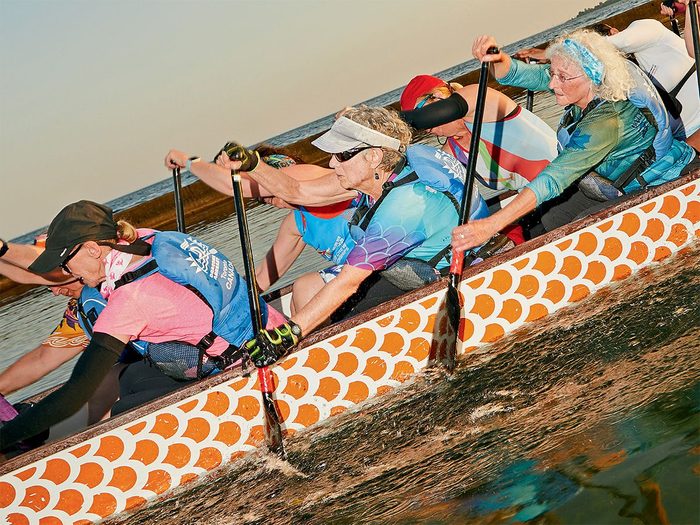
Friendship, determination and a breast cancer diagnosis unites the members of Dragons Abreast
“Listen up cause I’ve been told, D.A.’s going after gold! We’ve been down but always rise, D.A.’s gonna get first prize!”
The members of the Dragons Abreast dragon boat team end their chant with a resounding cheer. They turn to watch a race in progress while they wait for their own heat to be called. Five long boats—each carrying 20 paddlers, one steersperson at the back and a drummer at the front—surge toward the buoys that mark the finish line in perfect synchronicity.
All eyes are on the dragonheads at the front of the boats as each team pours every ounce of their strength into pulling ahead, inch by inch. It’s still early morning and the July humidity is climbing alongside the anticipation at the Hamilton Waterfest Dragon Boat Festival.
For some of the paddlers, this is their first regatta. Others are veterans with over two decades of dragon boating and paddling experience.
(Related: As a Cancer Journey Coach and Breast Cancer Survivor, I’m Changing the Narrative for Cancer)
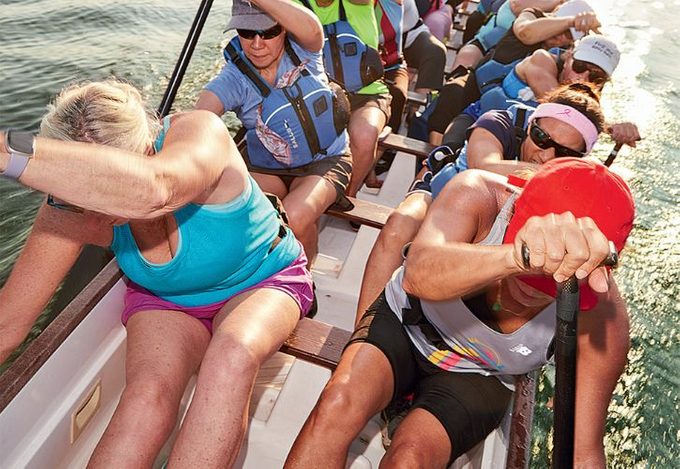
The History of Dragon Boat Racing
Dragon boat racing began as part of a cultural community event more than 2,000 years ago in China. On the fifth day of the fifth month of the lunar calendar (usually in late May or early June), races would be held in Chinese fishing villages to commemorate venerated statesman and poet Qu Yuan, who drowned in the river. The traditional holiday is also a time to perform rituals for good fortune and prosperity, and to ward off evil spirits. Over time, dragon boat racing evolved into what it is today: a global sport that draws in millions of athletes and spectators every year.
Dragons Abreast
The Toronto-based Dragons Abreast team stands out at this regatta for a few reasons. For one, its 79-member roster includes paddlers that range in age from 30 to 93. Prior to joining Dragons Abreast, some members hadn’t been part of a sports team since childhood and wouldn’t have described themselves as athletic. And what has brought these women together is something that none of them expected—living with breast cancer.
Breast Cancer in Canada
Breast cancer is the second most common cancer in Canada, with one in eight women diagnosed in their lifetime. Most breast cancer patients will have had either a lumpectomy to remove the tumour or a mastectomy to remove the entire breast. If the cancer has spread, they may also undergo an axillary lymph node dissection, where the lymph nodes near the armpits are removed.
Up until a few decades ago, people living with breast cancer were told to avoid physical activity. They were discouraged to take part in strenuous and repetitive upper body movement, because it was thought that exercise could cause lymphedema. This chronic condition, which has no cure, is characterized by swelling of the arms and hands caused by lymph fluid that can’t drain due to the surgical removal of lymph nodes, or damage by radiation.
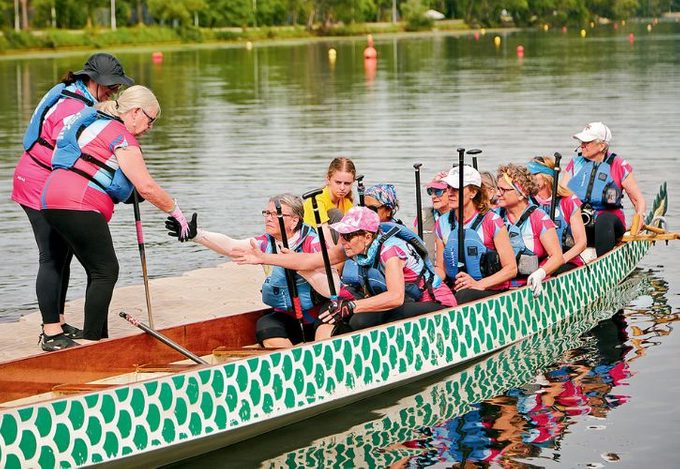
Dragon Boating for Breast Cancer Survivors
In 1996, Don McKenzie, a sports medicine physician and professor in the faculty of kinesiology at the University of British Columbia, launched a study to challenge the exercise-lymphedema connection. He recruited 24 volunteers, all with a history of breast cancer, to participate in a six-month-long dragon boat program. With its focus on paddling—which requires intense, repetitive upper body movement—the sport was the perfect vehicle to test out his hypothesis: that exercise didn’t cause lymphedema and would, in fact, be beneficial to survivors.
At the time, it was a bold experiment filled with unknown risks—and it paid off. There were no new cases of lymphedema among the women, several of whom reported improved range of motion in their shoulders and better mental health. The group made its debut as Abreast in a Boat at Vancouver’s 1996 dragon boat festival, officially becoming the world’s first breast cancer survivor dragon boat team.
McKenzie’s study was hugely influential in setting a new course for breast cancer recovery. Since then, there have been several more studies recognizing that exercise doesn’t cause lymphedema, and that it can actually reduce the amount of lymphedema that patients experience over time. Further research has shown that dragon boating offers survivors improved heart function, the benefits of community and improved health-related quality of life.
The breast cancer survivors on this team are in the same boat, literally and figuratively. For many, being part of a community that knows intimately how life changes after breast cancer is as beneficial as the physical gains. The team offers a supportive space to navigate all the complexities of survivorship, from regaining confidence post-treatment to remembering those who’ve passed on with a flower ceremony.
“I was so surprised at how emotional racing was for me,” says Liz Johnston Hill, the race coordinator for Dragons Abreast. “It’s almost overwhelming how people encourage you, no matter what.”
Today, there are more than 310 teams from 37 countries that are part of the International Breast Cancer Paddlers’ Commission—and 50 of them are from Canada.
When Dragons Abreast founder Eleanor Nielsen, now 85, was diagnosed in 1989 with stage two breast cancer, she underwent chemotherapy and a mastectomy, and had her lymph nodes removed. Back then, her doctors advised her to avoid using her surgical side.
“I was told I shouldn’t vacuum and carry groceries,” she recalls. “There was a whole pile of things I shouldn’t do.”
While working at the Canadian Cancer Society to help grow and promote their programs, Nielsen attended a conference in Vancouver, where she met members from the original Abreast in a Boat team.
“When I came home, I asked my husband, ‘Should I start a team in Toronto?’”
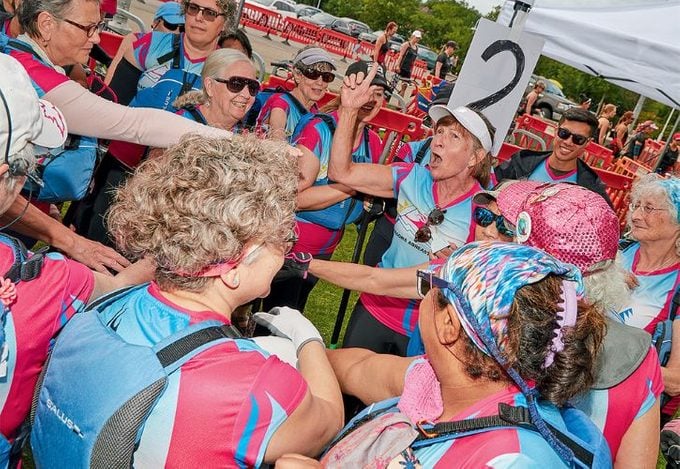
Dragon Boat Racing in Toronto
That led to the formation of Dragons Abreast in 1997. Now in its 26th season, the team has welcomed over 300 women and men living with breast cancer onto the boat. Together, they’ve travelled the world to compete in places like Panama, Australia and Italy.
In celebration of the team’s 25th anniversary last year, they paddled through Ontario’s Trent-Severn Waterway. Over six days they raised $38,000 for the Breast Cancer Support Fund, a nonprofit providing financial assistance to patients in need.
In 2021, Nielsen co-authored Internationally Abreast: Exercise as Medicine, which documents the history and rise of breast cancer dragon boat paddling across the world. She summarizes why the sport is integral to many survivors with a quote from McKenzie: You aren’t racing against each other; you’re racing cancer.
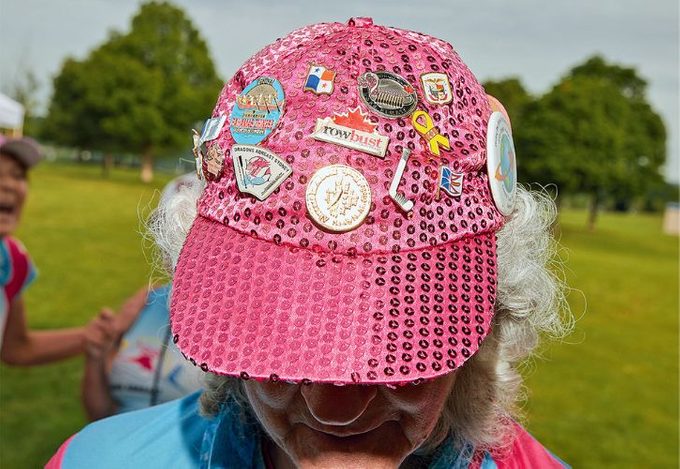
Regatta Day
Today at the regatta, Dragons Abreast members rest up at their tent. Lounging in camping chairs, the women chat and joke, passing around snacks like homemade baked goods, frozen orange slices and pretzel twists.
Pink is everywhere: the fuchsia Dragons Abreast logo, the light pink breast cancer awareness ribbons, hot pink tutus and manicures, and one member’s glittering sequin baseball cap adorned with pins collected from international regattas. It’s not hard to spot a breast cancer team, but the signs of cancer are sneakier.
Akaash Singh’s Journey With Breast Cancer
For Akaash Singh, 55, it was dryness around her nipple. Her first mammogram was clear, and Singh, who works in the pharmaceutical industry, just continued on with her demanding career.
“I saw the changes, but they were so gradual,” she says. “We know to look for lumps, but we don’t necessarily look for skin changes or associate that with cancer.”
Within a year, the symptoms progressed to redness around the areola and an inverted nipple. And they weren’t going away. Singh went back to her doctor and was immediately recommended to a surgeon, who felt a lump in her milk duct.
The biopsy came back positive for cancerous growth. Following Singh’s localized stage three diagnosis in 2012, she underwent a full mastectomy with lymph node dissection the day before her 45th birthday.
Singh joined Dragons Abreast after she finished treatment in 2014, and is now the organization’s chair. Before her diagnosis, she considered exercise to be secondary to work.
“I never really took that time for myself to keep my body healthy,” she says. Dragon boating has helped Singh reprioritize her health. “I’m not a morning person, yet I would get up at five if I had a regatta that day,” she says. “Something I wouldn’t do for anything else in my life.”
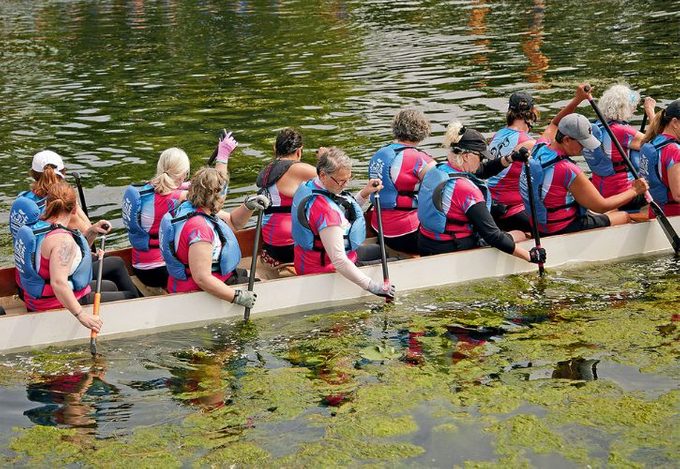
Benefits of Exercise and Breast Cancer
As the medical director of the After Cancer Treatment Transition clinic at Women’s College Hospital in Toronto, Carol Townsley stresses the importance of physical activity with all of her patients. It’s now standard to integrate physical activity into a recovery plan, all the way from light stretching to more rigorous sports like dragon boat, depending on the patient’s baseline fitness and comfort level.
“Breast cancer survivors are on drugs like tamoxifen or letrozole, which are estrogen blockers, and these drugs can have a lot of muscle or joint side effects,” she says. “There’s a lot of evidence that being active minimizes the side effects of these medications so [patients] can stay on them longer, which, in turn, decreases their chance of recurrence.”
From Townsley’s experience, patients who participate in group sports like dragon boating have better outcomes because of their camaraderie and dedication.
“One of the things that I’ve found as a clinician is that the passion patients have for dragon boating is unique,” she says. “If we can look for anything in sports or exercise, sticking with it and enjoying it is key.”
Shelagh Tyreman’s Experience With Breast Cancer
Shelagh Tyreman’s soprano voice rang sharp and clear as she sang the national anthem at the regatta. When the music stopped, her Dragons Abreast teammates burst into applause—a familiar sound to the 60-year-old classical musician. She began her training as a pianist, later switching to opera singing.
After performing all over the world, from Notre Dame to the Vatican, Tyreman is now a teacher and the music director for St. Andrew’s Presbyterian Church in Brampton. She was diagnosed with breast cancer in 2012 and completed treatment that same year, after a lumpectomy, six months of chemotherapy and six weeks of radiation.
But in 2019, she had a gut feeling that something was off. After having multiple clear mammograms and ultrasounds over the next three years, Tyreman finally confirmed her fears: a recurrence. Although she’s in active treatment again, dragon boat practice is still part of Tyreman’s weekly routine.
“Every time I have an appointment, the doctors tell me, ‘Whatever you do, keep paddling because it just keeps you so strong and fit.’”
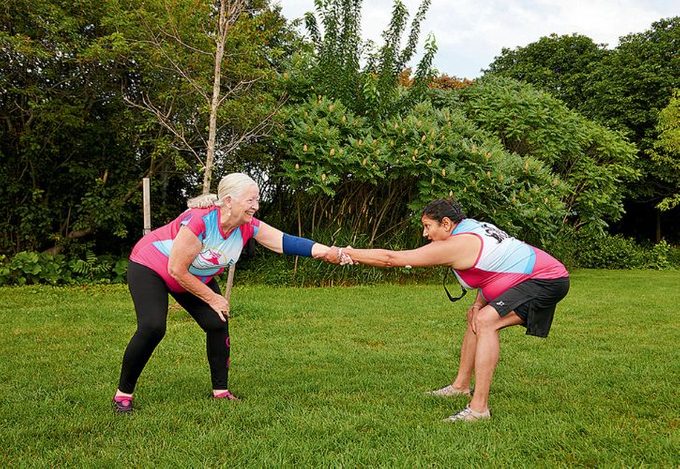
Somebody to Lean On
When Tyreman was first diagnosed in 2012, she kept her condition private and didn’t meet with any support groups. ”I just couldn’t at that time,” she says. “I felt very private about my diagnosis.”
Now, she credits Dragons Abreast and dragon boating for helping her face the second round. “I felt so betrayed by my body because I did everything I was supposed to and you just want to move on with your life,” she says.
“Paddling has given me not only physical strength but mental belief in the power of myself, of my soul, of who I am.”
Even when Tyreman feels nauseated from taking her oral chemotherapy drugs, being out on the water and with her teammates has become a healing balm.
“I know that if I’m having a rough day because of something to do with breast cancer, there’s about 40 to 60 people I can talk to,” she says. “I’m not alone anymore.”
Angela Fong, an assistant professor at the School of Kinesiology at the University of Michigan and the Rogel Cancer Center, agrees that dragon boating is a valuable way for patients to bond. Things like after-practice socials, spending time to master techniques and the competitive nature of racing all contribute to helping people move on from their diagnosis.
“They see themselves as survivors, but they also see themselves as athletes,” she says. “This additional social time allows them to talk and process that whole experience.”
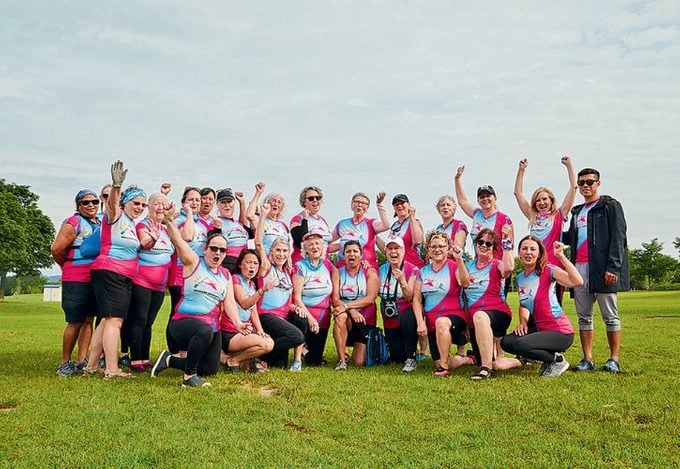
Finding Support as Survivors Through Dragon Boating
Tyreman stepped into a dragon boat for the first time seven years after her initial diagnosis. In 2019, she saw on Facebook that Dragons Abreast was having an open house to recruit new members and jumped at the chance.
“I was finally ready to do something publicly about being a breast cancer survivor,” says Tyreman. Although she had never paddled before, Tyreman knew that she wanted to seek out the community. “I was looking at all these strong breast cancer survivors,” she says. “I thought, I’m ready to meet them and maybe be one of them.”
After a long day of dragon boat racing, the members of Dragons Abreast proudly sport tangles of gold medals and bright pink ribbons around their necks as they pose triumphantly for a group photo.
In dragon boat racing, the difference between winning and losing can come down to less than a tenth of a second. For the team that day, it was a win by 0.13 seconds. But the paddlers insist they had already won before they ever stepped into the boat.
“You learn so much from all of these incredible women,” says Singh. “That not only makes you a better dragon boater, it also makes you a stronger person, and more comfortable in your skin.”
Next: Jeanne Beker on Finding Community and Support Through Her Breast Cancer Diagnosis




